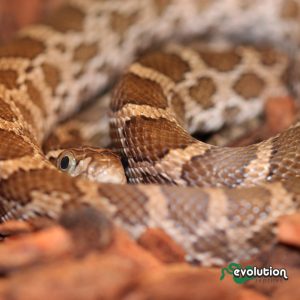Copyright 2021 Evolution Reptiles
All rights reserved.
Copyright 2025 Evolution Reptiles
All rights reserved.
All rights reserved.
Closely related to the corn snake, Great Plains rat snakes are found in the wild across the Central United States, from Missouri to Nebraska, to Colorado, south to Texas, and into northern Mexico. They have a light greyish brown background colour, with rich brown saddles outlined in black and a brown stripe through the eye and down onto the neck. The underside is white with regular black checkerboard markings, very like a corn snake. When crossed with a corn snake they produce ‘rootbeer’ corns, and amelanistic crosses are known as ‘creamsicles’.
A small to medium sized snake, they reach an adult size of between 61 and 90cm (24” to 36”, or 2 to 3 feet) although it’s more usual to be roughly in the middle of those sizes. They can be active at any time of the day or night, depending on time of year, day length and temperature. They can be long lived in captivity, to live well into their twenties is not unusual for a well cared for snake.

Part of their success in captivity is that they are such an adaptable species in the wild. They can be found in woodland, open grassland and meadows, rocky hillsides, urban scrub, around human habitation and even go so far as to move into abandoned buildings and sheds! They are just as eclectic with their diet; although they do eat mostly rodents, they will eat birds, raid nests for eggs and nestlings, take small lizards and even sometimes other snakes. It’s not unusual to find them hunting bats around cave entrances. They climb well, and can burrow in loose soil and leaf litter.
As a pet, a great plains ratsnake is one of the most straightforward of reptiles to keep. Even small hatchlings are happy to live in an adult sized enclosure as long as there are plenty of baby-sized hides to keep them feeling safe. Piles of loose cork bark are excellent for this, as are half coconut shells and the smaller resin hides. A humid hide filled with moss and kept in the warm end gives the corn snake its own personal sauna in which to curl up when it’s about to shed its skin.
Your snake needs a good sized enclosure, preferably 120cm x 60cm x 60cm (4x2x2’). We recommend using a thermostatically controlled deep heat projector mounted at one end with which you control the ambient temperature to give a hot spot to help them digest their food and encourage normal behaviour.
Temperatures should vary between 32ºC (86ºF) at the warm end to 25ºC (77ºF) at the cool end. Directly under the basking spot it can be a little warmer, but no higher than 35ºC. At night the temperature can drop to 20ºC (68ºF), although if it drops slightly lower there is no cause for alarm.
Although it has always been assumed that snakes do not need UV lighting, it is always a good idea to provide it. Low output T5 UV tubes are now available that can mimic the levels of UV that they would be exposed to in the wild, and we have found that when it is provided they will definitely use it.
A variety of different prey items should be offered, sized appropriately for the snake – generally speaking, they can take prey items slightly larger as the largest part of the body. Mice, rats, hamsters, gerbils, chicks – quail and chicken – are all available regularly, and should be used to vary your snakes diet.
Copyright 2021 Evolution Reptiles
All rights reserved.